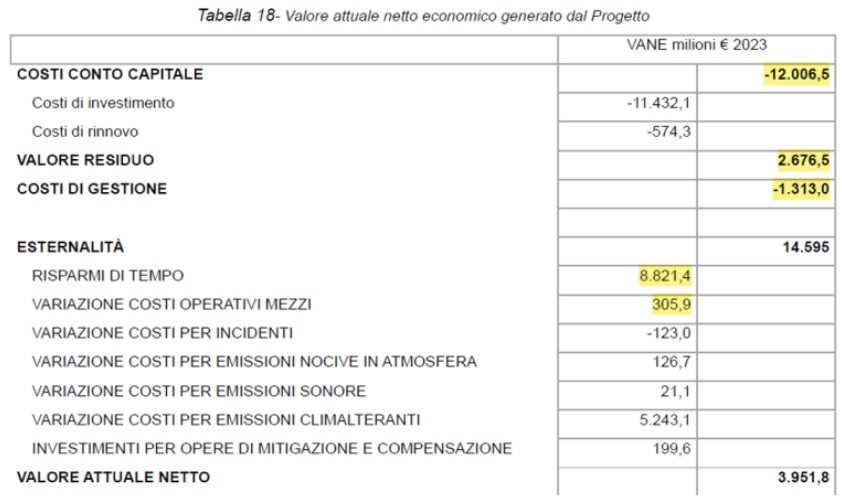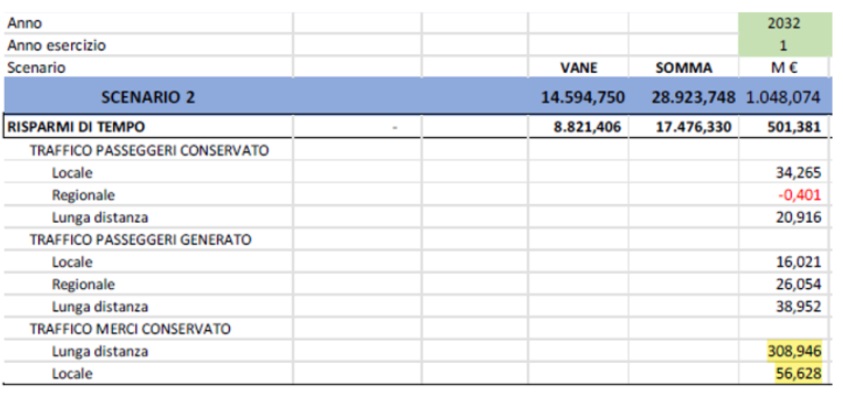Is the Strait Bridge wobbling under the weight of numbers?

What emerges from an analysis by Francesco Ramella, author of scientific publications on transport and expert in cost/benefit analysis of infrastructure, on the economic evaluation of the Bridge over the Strait of Messina drawn up by the same company that will carry out the work
Is the Bridge economically advantageous?
Francesco Ramella , executive director of Bridges Research and research fellow of the Bruno Leoni Institute and Iref, expert in cost/benefit analysis of road and railway infrastructures and environmental impact of transport systems, with a past from 2016 to 2019 as a consultant at the Technical Mission Structure of the Ministry of Infrastructure and Transport and a PhD in Transport at the Polytechnic of Turin, given his passion for bridges he dove headfirst into the cost-benefit analysis of the futuristic Strait Bridge wanted with force by the current owner of the Infrastructure Department, Matteo Salvini, and drawn up by the company “Stretto di Messina”, discovering various interesting information.
HOW MUCH DOES THE BRIDGE OVER THE STRAIT COSTS FOR THE SOCIETY OF THE STRAIT OF MESSINA
Although the document, underlines Ramella in an article on LaVoce.info , was written by the company concerned and not "as would be appropriate, by a third party" (after all, the external scientific committee chosen to evaluate the feasibility of the Strait Bridge of Messina in 51 pages of his report reported 68 critical issues), the data it contains still allow Ramella to state that it is a "failure" work.
In fact, we read: "For construction and management costs, net of the residual value at the end of the analysis period, estimated at 10.6 billion, the economic benefits, given by the sum of time savings and reduction in operating costs of means of transport, amount to 9.1 billion (figure 1).”

“The fact that the time savings for freight vehicles are estimated, in the first year of operation, to be equal to 365 million (figure 2), i.e. almost triple compared to those for passengers, despite the fact that the number of heavy vehicles that currently use the ferries is around 800 thousand units, compared to more than ten million people who cross the Strait every year".

For Ramella, the only "factor that changes the direction of the analysis is represented by the benefits in terms of reducing climate-altering emissions, estimated at 10.6 billion at current values. Put another way, if climate change did not exist, the Strait Bridge would be not only economically but also socially harmful.” At the end of a detailed reasoning on the point, the expert sadly concludes: "it can be said that the socio-economic feasibility of the Bridge "hangs" on an extraordinarily inefficient emission reduction hypothesis" –
THE COMPANY DEFEATS SALVINI
Even without going into the technicalities dissected by Ramella, two things are surprising. The first naturally concerns the company itself admitting that it is not an economically advantageous project.
The second is the fact that this analysis completely disavows what Matteo Salvini instead repeats as a leitmotif every time he has a microphone turned on in his hand. At least in this last period, given that in the recent past Salvini instead opposed the construction , suggesting allocating the money for the work to that needed "to fix the schools".
“Work on the bridge is progressing. It is something that not only the Sicilians and Calabrians, but all Italians have been waiting for for fifty years", declared the Northern League deputy prime minister on 6 April on the sidelines of the conference 'Differentiated autonomy of the regions with ordinary statute' underway at the Museo dell' Turin car. “It will be – he added – an enormous job opportunity for the whole of Italy which is estimated at 120 thousand direct and indirect jobs created in the years of construction, as happened for the TAV, and it will be an environmental saving with less pollution, more speed, more connection”.
Last December Salvini went even further by stating: "It is a bridge that does not connect Messina to Villa San Giovanni, but unites Palermo, Rome, Milan, Berlin, Stockholm and the rest of the world." And to make it digestable by the entrepreneurs of the North, the historical electoral base for the League, the leader of the Northern League, speaking at the conference of the Foundation for the subsidiarity of infrastructures in Torre Pwc in Milan, said: "The first Italian region for GDP increase from the construction of the bridge it is the Lombardy region, which alone would have a +30%. Around 10 thousand jobs counted in Lombardy alone and 5.6 billion in additional GDP. The bridge is not just for territorial continuity." However, it seems that he forgot to inform the Stretto di Messina company which belongs to the consortium headed by Webuild about all these benefits.
This is a machine translation from Italian language of a post published on Start Magazine at the URL https://www.startmag.it/smartcity/il-ponte-sullo-stretto-traballa-sotto-il-peso-dei-numeri/ on Mon, 08 Apr 2024 10:51:40 +0000.
